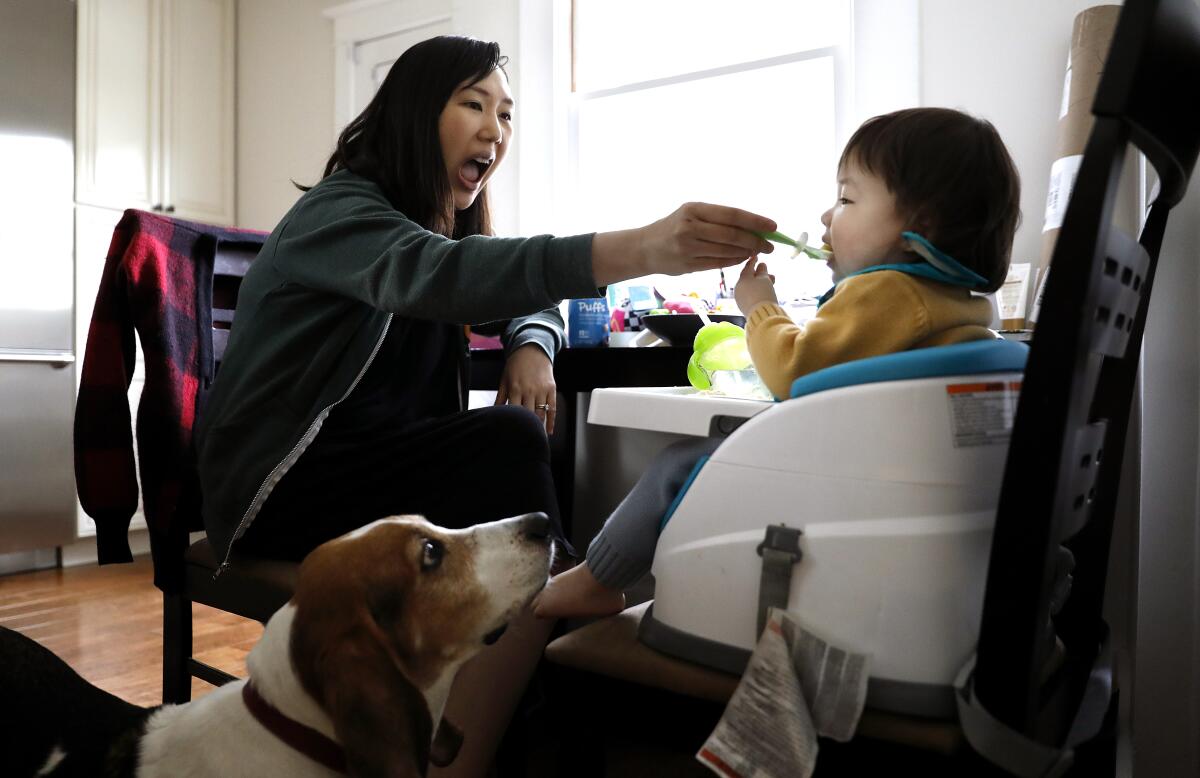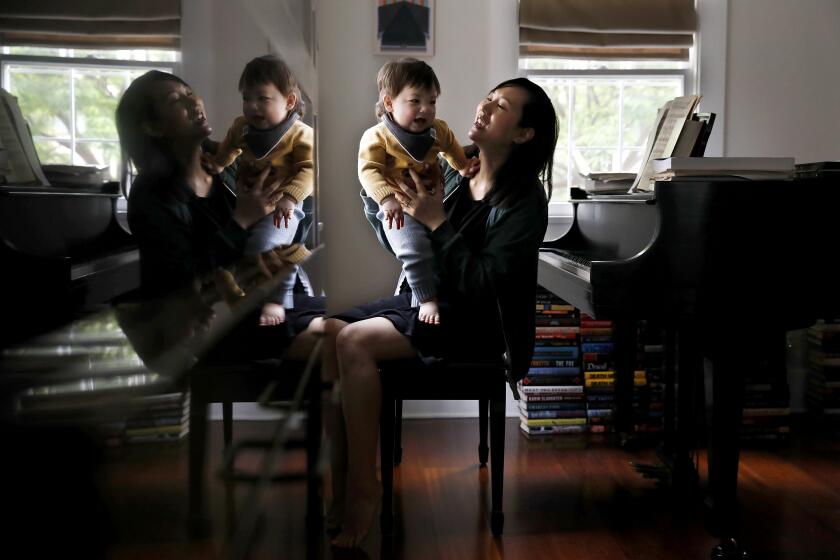8 to 3: Is the COVID baby bust my fault?

- Share via
This is the May 24, 2021, edition of the 8 to 3 newsletter about school, kids and parenting. Like what you’re reading? Sign up to get it in your inbox every Monday.
Do you ever feel like the headlines are yelling at you?
That’s how I felt when the COVID-19 “baby bust” started to make news this winter. As a millennial mom, it was quite obvious to me why my peers were putting off children, or having fewer than our parents, as my husband and I had done. It made perfect sense, and yet the story went on repeating incredulously, over and over, for months. It was as though all our mothers-in-law had conspired with the top editors of every national newspaper (who are, let’s be honest, their peers) to shame us for not having children — or to be more demographically precise, for not having more.
This week, I wrote about how greater access to IUDs and other forms of highly effective, long-acting reversible contraceptives under the Affordable Care Act helped parents and would-be parents avoid pregnancy in larger numbers this year. My story focused on California, where the drop in births is expected to be particularly steep.
The humble IUD is just one of many reasons California is expected to see almost 50,000 fewer births in 2021, the nadir of a national COVID ‘baby bust.’
Although the drop may be more dramatic here, it’s by no means a California- or even U.S.-specific phenomenon. As the New York Times reported extensively this weekend, falling birth-rates are a long-term global trend, and while contraceptives are an interesting and unexpected part of it, they’re not the whole story.
Experts have known for decades that greater educational attainment and economic advancement for women leads to lower birth rates. If you’re a millennial with a uterus like me, you’re used to hearing this framed as a kind of unique generational selfishness: We’re too busy polishing our participation trophies or drowning in our student debt to start our own families.
Except that’s not true — at least not statistically. Most millennial women were already mothers in 2018, the year childcare became more expensive than housing in California. Maligned as we are, millennials are not exempted from eons of social expectations or millions of years of evolutionary biology. If we were, we wouldn’t be paying the equivalent of Cal State tuition to send our offspring to preschool.
What data seem to show instead is that we’re having children later, and having fewer than our mothers and foremothers did. From a public health perspective, this is an unalloyed good: Carrying your first pregnancy at 16, as my grandmother-in-law did, is far more biologically dangerous to mother and baby than doing it at 29, when I was pregnant with my son.
As of last year, complications from pregnancy and childbirth were still the leading cause of death for adolescent girls around the world. Babies born less than 18 months apart are much more likely to come early and be underweight compared with those who are spaced at two years or more, which is just one of the many reasons women in other countries will routinely get an IUD placed within minutes of delivery. (The reason so few Americans get post-placental IUDs is that Medicaid doesn’t have a code for it in most states.)
Economically, too, what’s good for mothers and babies is good for families and communities — something the anarchist Emma Goldman understood in 1916, when she was arrested for lecturing on contraception in New York City. At that time, birth control was functionally illegal in the U.S., and even alluding to it in public could land you in prison. The result was what Goldman called “incontinent fruitfulness” — the dehumanizing inability to control, by even the slightest degree, when, how or how often one had children.
Few would argue that women’s economic advancement and reproductive control are negative. Yet the result of these triumphs is framed to us as a demographic disaster.
That’s felt especially true in the U.S., where mothers of young children were disproportionately harmed by COVID unemployment and prolonged school closures. We’ve gotten used to acknowledging that the majority of people who lost their jobs were low-income women of color, but not that they were mothers, which is equally statistically true.
Which leads one to wonder: Why would the rational and historically precedented choice to delay childbearing during a once-in-a-century pandemic be framed as the whim of childless women, when it was mostly the economic calculus of mothers?
Speaking of calculus ...
If you’re a parent of a student in California public schools, you’ll want to know about the sweeping changes in math curriculum proposed last week. Among other things, they begin with the radical notion that calculus is not necessarily the pinnacle of a typical high school math education. As The Times’ Howard Blume explains, the new Mathematics Framework is intended to broaden numeracy in most students. But critics worry that it’ll hold back the brightest math minds.
The big change is that all students would study the same math subjects until their junior year of high school, at which point they’d be allowed to move on to more advanced topics. State Board of Education President Linda Darling-Hammond describes it as an effort to drag math education (kicking and screaming) into the 21st century — from the 19th. “The old [way], the idea that calculus is the capstone, is one that originates with a committee of 10 men in 1892,” she said.
Fine, critics say, but the new way of teaching is going to hold back the most advanced students by making them advance at the pace of the slowest students. “This is a disservice to all of our students,” Deanna Ponseti, a teacher at Warren T. Eich Middle School in Roseville, northeast of Sacramento, wrote in comments submitted to the state Instructional Quality Commission, which ultimately approved the new guidelines.
The guidelines now go to the state Board of Education, which is expected to make its final decision in November. Expect lots of debate before then. Here’s a primer where you’ll find more background on the issues involved.
Enjoying this newsletter?
Consider forwarding it to a friend, and support our journalism by becoming a subscriber.
Did you get this newsletter forwarded to you? Sign up here to get it in your inbox every week.
Is this the end of the pandemic as we’ve known it?
There have been few more contentious issues in the country these past few months than when schools can and should safely open for full in-person instruction. Passions run high on both sides; on Sunday, some 70 parents gathered outside Los Angeles Unified School District headquarters to demand that schools NOT reopen fully in the fall. On Monday, Supt. Austin Beutner delivered his response, and it was unequivocal: “Looking down the path to recovery and the new school year which starts this fall, all students will have the opportunity to participate in full-day, on-campus, in-person instruction.”
Needless to say, not everyone is thrilled. But the teachers union, so far, has simply noted the superintendent’s plans and said it would fight to ensure that all appropriate health and safety standards are upheld.
It’s inexorable, though: At some point, school will return to normal. In the meantime, we still have weird hybrid efforts to maintain some semblance of normalcy. Yearbooks, for instance.
My colleague Laura Newberry spent time with the staff of the Redondo Union High School yearbook staff, which is trying valiantly to produce a yearbook that contains something other than screenshots of Zoom gatherings. “Their daunting mission,” Newberry wrote, “has been to fill scores of blank pages even though student life as traditionally documented was all but nonexistent.”
You’ll have to read the full story to learn exactly what they did, but suffice to say that it included lots of student selfies, as many photos as the yearbook photographers could take when students ventured out of their houses and, yes, some screenshots of Zoom gatherings. “Yearbook is a time capsule of the year, and we can’t really ignore the fact that we’re on Zoom 24-7,” said senior Meena Kabbani, an editor of the yearbook.
I want to hear from you.
Have feedback? Ideas? Questions? Story tips? Email me. And keep in touch on Twitter.
Here’s what else we’re reading
The past year of racial reckoning around the country was tough on kids, tough on parents and tough on teachers, even if many of them would acknowledge that it was long overdue and necessary. But it was especially tough on Black teachers, who were tasked with explaining what was happening to students, explaining it again to white colleagues, and coping with backlash from parents and fellow teachers who didn’t understand the complaints about racism. There’s a phrase to describe what was happening, Peggy Barmore wrote in the Hechinger Report: “racial battle fatigue.”
It was a senior prom like no other — that’s a truism that could be said about any senior formal held this year. A lot has been written about these rituals; here’s one take from EdSource.
And we couldn’t resist this story about the latest assistant in some Mexican schools, recruited to screen students for signs of COVID-19. This is a sophisticated worker, employing medical-grade cameras, temperature sensors and AI software capable of evaluating in seconds whether a child has some kind of health problem. Benebot is also a robot, which means it isn’t very demanding and doesn’t eat a lot — although it does claim to have a “stomach.” Here’s the story from our sibling newspaper, the San Diego Union-Tribune.
Sign up for Essential California
The most important California stories and recommendations in your inbox every morning.
You may occasionally receive promotional content from the Los Angeles Times.








